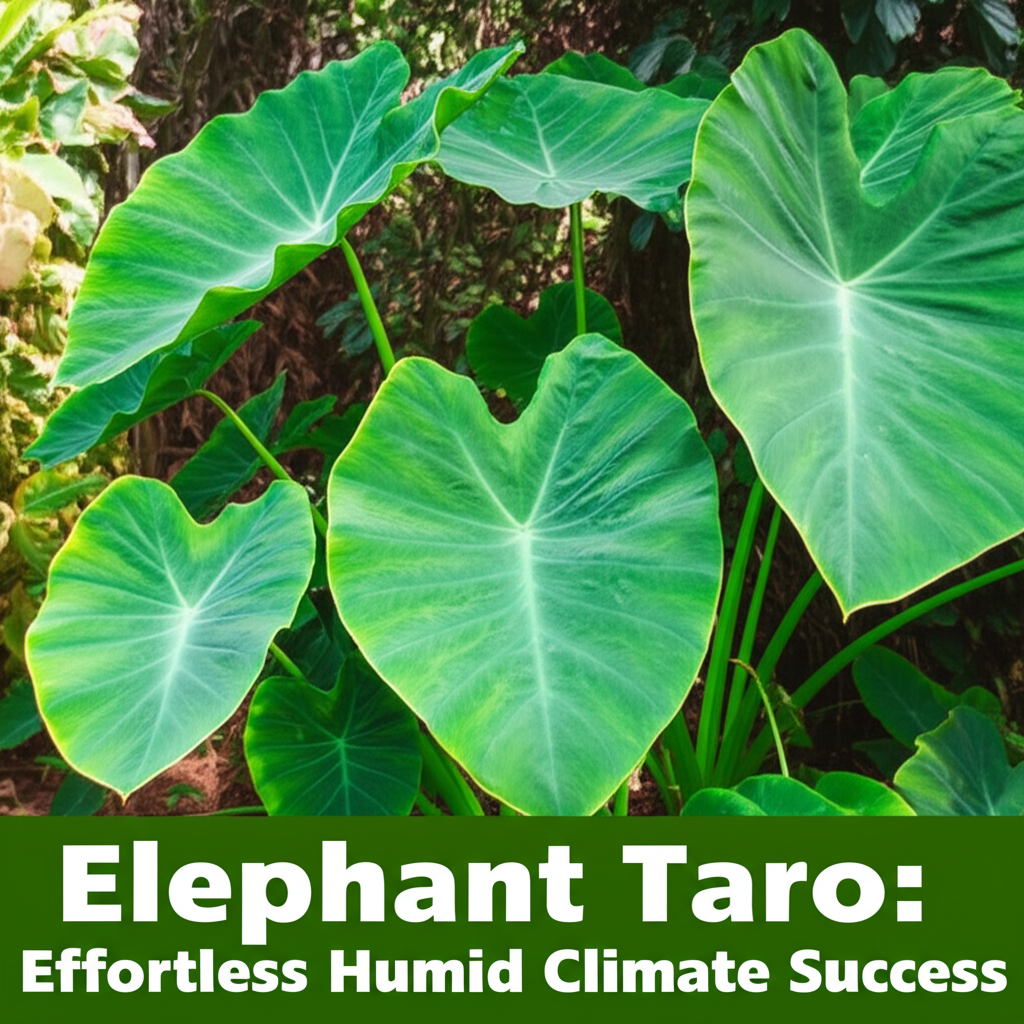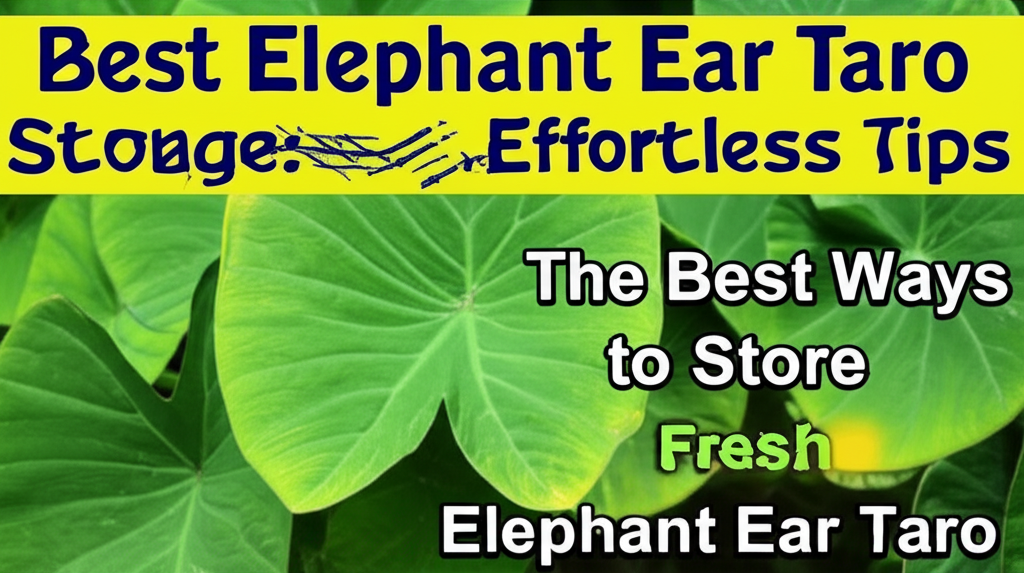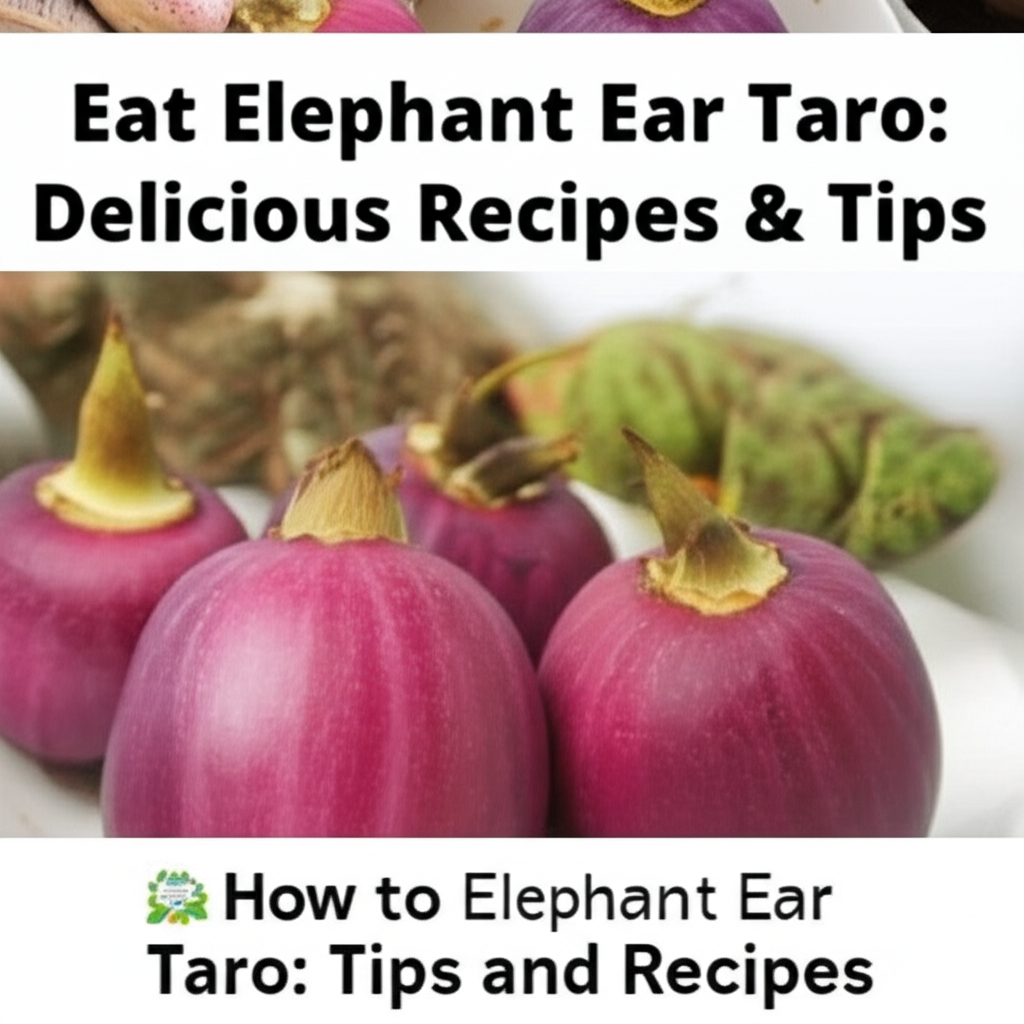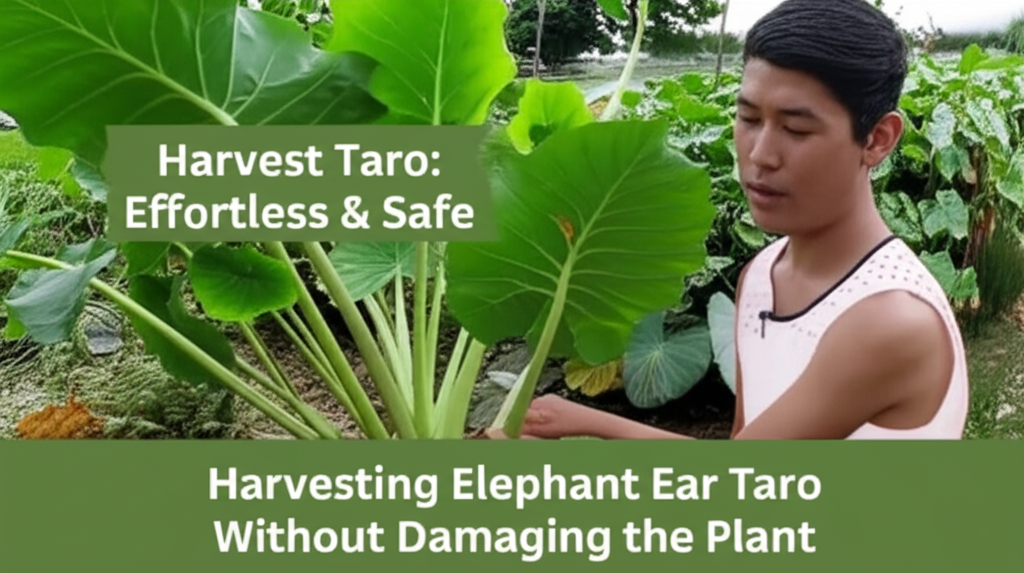Adapting Elephant Ear Taro to Humid Climates: Effortless Humid Climate Success

Can you imagine a garden that thrives even when the air hangs thick and heavy, a garden where lush, tropical foliage creates a stunning visual spectacle without demanding constant fuss? For many, the allure of the majestic Elephant Ear Taro (Colocasia esculenta) is undeniable, but the thought of coaxing these tropical giants to flourish in a humid climate can feel daunting. What if we told you that adapting Elephant Ear Taro to humid climates isn’t just possible, but can lead to truly effortless, breathtaking displays of natural beauty? This question is paramount for anyone living in or aiming for a tropical aesthetic, as understanding the specific needs of these plants in high-humidity environments directly impacts their health, vigor, and the overall success of your garden sanctuary.
Quick Answer Box
Yes, Elephant Ear Taro thrives in humid climates when provided with consistent moisture, partial shade, and nutrient-rich soil. Proper management of its watering needs, protection from intense midday sun, and appropriate soil preparation are key to ensuring its vibrant growth and preventing common issues in humid conditions.
What is Elephant Ear Taro and Why It’s Important in Gardening
Elephant Ear Taro, scientifically known as Colocasia esculenta, is a popular tropical plant celebrated for its dramatic, oversized leaves that resemble elephant ears. These perennial plants are grown both for their ornamental value, adding a bold, architectural element to landscapes, and for their corms, which are edible and a staple food in many cultures worldwide. In gardening, Colocasia esculenta is prized for its ability to create an instant tropical paradise, bringing a sense of the exotic to ponds, water features, borders, and containers. Its large, paddle-shaped leaves unfurl to create a lush canopy, providing shade and a dramatic focal point.
The importance of understanding how to adapt Elephant Ear Taro to humid climates lies in its natural habitat. Colocasia esculenta is native to Southeast Asia, a region characterized by high temperatures and significant rainfall. Therefore, humid climates are inherently conducive to its growth. However, simply planting it in a humid environment doesn’t guarantee success. The specific microclimates within a garden, soil conditions, and management practices play crucial roles. When adapted correctly, these plants contribute significantly to a garden’s aesthetic appeal, offering a sense of abundance and luxuriant growth, while also supporting local wildlife by providing habitat and attracting pollinators when in bloom.
Quick Recommendations or Key Insights about Adapting Elephant Ear Taro to Humid Climates
Embrace the Moisture: Humid climates naturally provide the high humidity Elephant Ear Taro craves. Ensure consistent soil moisture without waterlogging.
Seek Partial Shade: While they love warmth, intense midday sun can scorch their large leaves, especially in humid, hot conditions. Dappled shade or morning sun is ideal.
Feed Generously: These are heavy feeders. Regular fertilization is crucial for robust growth and large leaf production in humid, nutrient-depleted soils.
Provide Good Drainage: Even in humid areas, stagnant water can lead to root rot. Amend soil to ensure good drainage.
Watch for Pests: High humidity can sometimes encourage certain pests like aphids or spider mites. Regular inspection is key.
Consider Wind Protection: Large leaves can be susceptible to wind damage. Planting in a sheltered location or providing support can be beneficial.
Detailed Breakdown of Adapting Elephant Ear Taro to Humid Climates
Adapting Elephant Ear Taro to humid climates involves understanding its physiological needs and how they align with or can be supplemented by the prevailing environmental conditions. This section will delve into the specifics, offering a comprehensive guide for success.
The Science Behind Elephant Ear Taro’s Love for Humidity
From a botanical perspective, Colocasia esculenta is a semi-aquatic plant. Its natural habitat often includes marshes, swamps, and the banks of rivers and lakes. This indicates a high tolerance for moist soil and, crucially, high atmospheric humidity. The large surface area of its leaves is adapted to maximize photosynthesis in conditions where water is readily available. In humid environments, the air’s water vapor content is high, which reduces the rate of transpiration – the process where plants release water vapor through their leaves. For plants that are adapted to moist conditions, this reduced transpiration can be beneficial, as it conserves water.
However, in extremely humid and stagnant conditions, the risk of fungal diseases increases because moisture can linger on the foliage. The plant’s ability to thrive is also linked to temperature. Colocasia esculenta prefers warm temperatures, typically between 65°F and 85°F (18°C – 29°C). Humid climates often provide these ideal temperature ranges, creating a perfect synergy. The plant’s rhizomatous root system is designed to store energy and water, allowing it to endure periods of less-than-ideal conditions, but consistent moisture is key to its vigorous growth.
Practical Applications in the Garden: Mimicking the Tropics
Bringing the tropical allure of Elephant Ear Taro into your garden in a humid climate is about replicating its native conditions as closely as possible.
Location, Location, Location: Choose a spot that receives dappled sunlight or morning sun. Avoid full, intense afternoon sun, which can cause leaf scorch, especially when combined with high humidity that can trap heat. Areas near water features, ponds, or even a consistently moist garden bed are excellent choices. If you don’t have a naturally moist spot, consider planting near a downspout or in a location where you can easily provide consistent watering.
Soil Preparation is Paramount: The key to success in humid climates is ensuring excellent drainage, even though the plants love moisture. Heavy, clay soils common in some humid regions can become waterlogged. To combat this, amend your planting beds with plenty of organic matter such as compost, well-rotted manure, or peat moss. This improves aeration and drainage while also providing essential nutrients. For container planting, use a high-quality potting mix designed for tropical plants or add perlite and compost to a standard potting mix.
Watering Wisely: While humid climates offer ambient moisture, the soil still needs consistent watering, especially during dry spells or when plants are actively growing. The soil should feel like a damp sponge – moist but not saturated. The best way to check is to stick your finger about two inches into the soil. If it feels dry, it’s time to water. Overwatering in humid conditions can be as detrimental as underwatering, leading to root rot.
Feeding for Flourishing: Elephant Ear Taro are hungry plants, and their rapid growth in warm, humid conditions demands a consistent supply of nutrients. Use a balanced, slow-release fertilizer (e.g., 10-10-10) at the beginning of the growing season. As the plant establishes and begins to produce its impressive foliage, switch to a fertilizer higher in nitrogen (e.g., 20-10-10) to promote leaf growth. Apply liquid fertilizers every 2-4 weeks during the peak growing season, or use slow-release granules as directed on the packaging.
Container Gardening for Control: If your garden soil isn’t ideal or you want to control the growing environment precisely, container gardening is an excellent option. Large pots (at least 10-15 gallons) are necessary to accommodate the extensive root system. Ensure the pots have ample drainage holes. This method also allows you to move the plants if they are receiving too much sun or wind.
Common Mistakes to Avoid When Adapting to Humid Climates
Even in its preferred environment, gardeners can make missteps. Being aware of these common errors will help you avoid them.
Overwatering in Waterlogged Soil: This is perhaps the most critical mistake. Humid climates can lead to a false sense of security regarding watering. If your soil doesn’t drain well, even if it’s naturally moist, the roots can suffocate and rot. Always prioritize good drainage.
Too Much Direct Sun: While these plants need warmth and light for photosynthesis, intense, direct afternoon sun in humid conditions can be harsh. The combination of high heat, humidity, and direct sun can quickly lead to leaf scorch, making the plant look unkempt.
Neglecting Fertilization: The rapid growth rate of Colocasia esculenta in warm, humid conditions depletes soil nutrients quickly. If you don’t fertilize regularly, the plant will become leggy, produce smaller leaves, and may even stop growing.
Poor Air Circulation: In densely planted areas within humid gardens, poor air circulation can create microclimates that encourage fungal diseases. Ensure there’s some space between plants for air to move.
Underestimating Wind Damage: Those magnificent leaves act like sails. In windy, humid areas, they can easily tear or be ripped from the stems, ruining the aesthetic. Planting in sheltered locations or providing support is often necessary.
Ignoring Soil pH: While Colocasia esculenta is adaptable, it prefers slightly acidic to neutral soil (pH 5.5-7.0). In some humid regions, soils can become more acidic over time due to heavy rainfall. Testing your soil pH and amending it if necessary can improve nutrient uptake.
Expert Tips or Pro Insights for Peak Performance
Seasoned horticulturists have learned a few tricks for maximizing Elephant Ear Taro’s potential in humid environments.
Feed the Foliage: For truly spectacular leaf production, consider foliar feeding. A diluted liquid fertilizer applied directly to the leaves can provide a rapid nutrient boost, especially during the peak growing season.Mulching for Moisture and Temperature Regulation: Apply a thick layer of organic mulch (wood chips, straw, shredded leaves) around the base of the plant. This helps retain soil moisture, suppresses weeds, and moderates soil temperature, which is beneficial even in warm climates.
Strategic Planting for Visual Impact: Group plants with varying leaf colors and textures for a more dynamic display. Consider planting shorter, mounding plants around the base of Elephant Ears to create a layered look and to help retain moisture at the soil level.
Divide and Conquer: Over time, the rhizomes of Elephant Ear Taro will spread and multiply. Periodically dividing these clumps (usually in early spring before new growth begins) will rejuvenate the plants and prevent them from becoming overcrowded, which can lead to smaller leaves and reduced vigor.
Pest Patrol: In humid conditions, keep an eye out for common pests like aphids, mealybugs, and spider mites. A strong blast of water from a hose can often dislodge aphids. For more persistent infestations, insecticidal soap or neem oil are effective organic solutions. Regularly inspect the undersides of leaves.
The “Black Magic” of Compost Tea: For a nutrient-rich boost that also promotes beneficial soil microbes, steep compost in water to create compost tea. Apply this liquid gold regularly during the growing season for exceptionally healthy plants.
Seasonal or Climate Considerations in Humid Regions
While humid climates are generally favorable, there are nuances to consider throughout the year.
Spring: This is the ideal time to plant or divide Elephant Ear Taro rhizomes. As temperatures warm and the soil begins to moisten, the plants will awaken from dormancy and start their rapid growth. In regions with a distinct rainy season, ensure good drainage is established before the heaviest rains arrive.Summer: This is the peak growing season. Consistent watering and regular feeding are crucial. Watch for signs of stress like wilting, which can indicate a need for more water or shade. Continue to monitor for pests and diseases, as the warm, moist conditions can be conducive to their proliferation.
Autumn: As temperatures begin to cool and daylight hours shorten, growth will slow. In frost-free humid climates, the plants may continue to grow year-round. In areas with occasional frost, the foliage may die back, but the rhizomes will typically survive if protected.
Winter: In tropical and subtropical humid regions, Elephant Ear Taro may remain evergreen. If frost is a possibility, it’s best to mulch heavily around the base of the plant or dig up the rhizomes and store them in a cool, dry place until spring. If grown in containers, they can be brought indoors or into a protected, unheated space.
Buying Guide or Decision-Making Process for Elephant Ear Taro
When selecting Elephant Ear Taro, whether you’re buying rhizomes or potted plants, consider these factors to ensure you bring home a healthy specimen suited for your humid garden.
Rhizome Quality: Look for firm, plump rhizomes that show no signs of rot, mold, or soft spots. A healthy rhizome will have visible “eyes” or growth points. If buying online, choose reputable suppliers known for quality bulbs.Potted Plant Health: Inspect the foliage. Leaves should be vibrant green (unless you’ve chosen a colored variety) and free from tears, spots, or signs of insect infestation. The soil should be moist but not waterlogged.
Variety Selection: Colocasia esculenta comes in many cultivars with different leaf colors, sizes, and growth habits. Some popular choices for humid climates include ‘Black Magic’ (deep purple leaves), ‘Maui Gold’ (chartreuse leaves), and ‘Royal Hawaiian Waikiki’ (pink and green variegated leaves). Research varieties to find one that suits your aesthetic and the specific conditions of your garden.
Size Matters (for Pots): If purchasing a potted plant, consider the pot size relative to the plant’s size. A plant that is severely root-bound may struggle to establish quickly. For larger specimens, ensure the pot is adequately sized for future growth.
Source Reliability: Purchase from trusted nurseries or garden centers. They can often provide advice tailored to your local climate and soil conditions.
FAQ Section for Adapting Elephant Ear Taro to Humid Climates
Q1: Can I plant Elephant Ear Taro directly in a pond in a humid climate?
A1: Yes, Colocasia esculenta is well-suited for pond margins and boggy areas, making it ideal for humid climates where these conditions are common. Ensure the rhizome is planted in soil that is consistently moist but not completely submerged for extended periods, unless you are using a specific aquatic variety.
Q2: My Elephant Ear leaves are turning yellow in my humid garden. What could be the cause?
A2: Yellowing leaves can be caused by several factors. In humid climates, it’s often due to overwatering and poor drainage, leading to root rot. It could also be a sign of nutrient deficiency (especially nitrogen), insufficient light, or even a fungal issue. Assess your watering habits, soil drainage, and consider a fertilizer boost.
Q3: How do I protect my Elephant Ear Taro from fungal diseases in a very humid environment?
A3: Good air circulation is key. Avoid overcrowding plants and prune away any dead or diseased foliage promptly. Ensure excellent drainage to prevent the soil from becoming waterlogged. Consider applying a preventative organic fungicide or a copper-based spray if fungal issues are persistent.
Q4: Can Elephant Ear Taro grow in full sun in a humid climate?
A4: While they need light, Colocasia esculenta generally prefers partial shade or dappled sunlight, especially in humid, hot conditions. Full sun, particularly intense afternoon sun, can lead to leaf scorch and stress, even in a humid environment. Morning sun is usually tolerated well.
Q5: When is the best time to divide Elephant Ear Taro rhizomes in a humid climate?
A5: The best time to divide is in early spring, just as new growth is emerging or before the plant actively starts growing. This allows the separated rhizomes to establish themselves in the warming soil before the peak heat and humidity of summer.
Conclusion for Adapting Elephant Ear Taro to Humid Climates
Successfully adapting Elephant Ear Taro to humid climates is an achievable goal that unlocks a world of lush, tropical beauty for your garden. By understanding its preference for consistent moisture, protection from intense sun, nutrient-rich soil, and good drainage, you can create the perfect environment for these majestic plants to flourish. Embrace the inherent advantages of your humid climate, but remain vigilant against common pitfalls like overwatering and poor air circulation. With thoughtful planting, diligent care, and by implementing the expert tips shared, you can transform your garden into a vibrant, exotic sanctuary that truly captures the essence of the tropics. Start planting and watch your Elephant Ear Taro thrive, bringing effortless, humid climate success to your doorstep.



